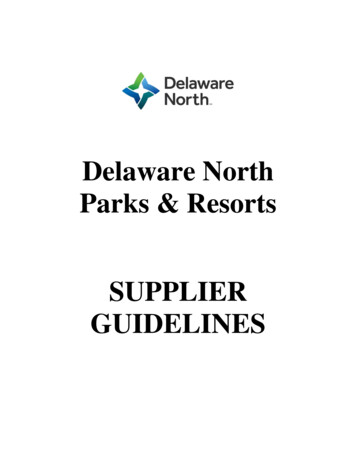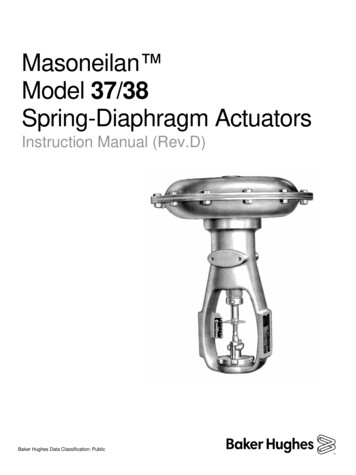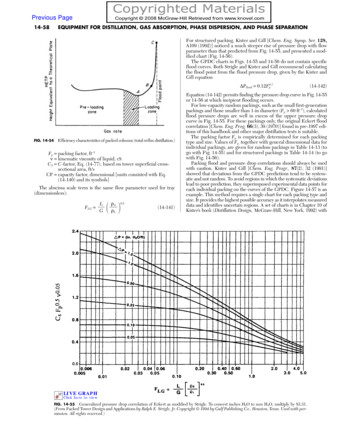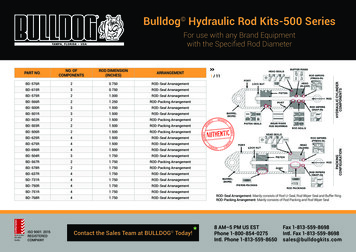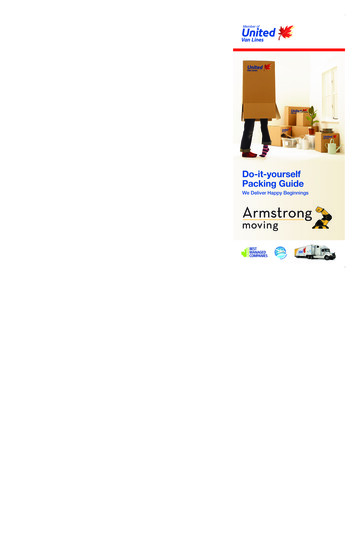
Transcription
Drawers: Remove valuables and anything that will leak or spill. Stuffdrawers with paper to keep articles in place.Canned goods, preserves, small food packages: Use up asmuch food as possible before you move. Do not ship canned goodsduring freezing weather. Do not ship perishables. Avoid moving glasscontainers; if you must ship them, seal in watertight packaging andplace upright in cartons.Tools: Dismantle large tools for moving. Wrap smaller tools andpack in small cartons since they are heavy. Remove all fuel from allgasoline-powered tools.Plants: Movers do not accept liability for plants damaged by frost,poor packing or adverse conditions. Plants are shipped at your ownrisk.Window coverings: Fold curtains and drapes lengthwise over ahanger, pin them securely and place in a wardrobe container. Theycan also be folded and packed in large cartons.Mops, brooms, curtain rods: Bundle them together with tape ortwine. You are responsible for removing drapery tracks, curtain rodsand other items attached to the walls, ceiling or floors.Rugs: Leave them flat on the floor. If they have just been cleaned,leave them rolled.Garden furniture, swings, sheds: Disassemble and place nuts andbolts in a labeled plastic bag and pack in a carton.Packing Tips No carton should be so large that it will obstruct the view whencarried or be over 23kg (50lbs) when packed. Do not over fill or under fill cartons; this practice increases the riskof damage. Tops must close flat and be sealed with tape. Wrap all items separately to protect fine surfaces. Wrap small articles in colored paper so they will not be discardedwith packing material. If you must ship liquids, fasten and tape lids, seal in a plastic bagand place upright in a carton. Record the contents of each carton in a notebook. Label eachcarton with your name and room location. Tape small pieces and screws to the item they belong to orput them in a carton labeled Set-Up Carton for easy access atdestination. Place items from desks and drawers in small, labeled cartons.Loose clothing may remain in dresser drawers. Place a Do Not Move sign on items which are to remain in thehouse. Assign a place for suitcases and other items that are not to beloaded in the moving van or container. Send your valuables (jewels, furs, important papers, etc.) byregistered mail or security carrier, or carry them with you. Wecannot accept responsibility for their shipment. Roll and tie electrical cords so they will not tangle. Prepare a Load Last-Unload First carton for things you will need assoon as you arrive in your new home.Questions?Ask your United Moving Consultant or call (800) 668-5544for further information about our moving tips.You can also reach us; by e-mail: marketing@uvl.ca at our web site: www.uvl.comDo-it-yourselfPacking GuideWe Deliver Happy Beginnings Pack heavier items on the bottom and lighter items on top. Packarticles snugly so they will not shift. Cushion every carton with clean, crushed paper; on the bottom,between layers, at the top, and in any empty spaces betweenarticles. Pack small articles in small boxes and nest them into a large box. Wrap fabrics and china in clean newsprint.United Van Lines (Canada) Ltd.,7229 Pacific Circle, Mississauga, ON L5T 1S91-800-668-5544 www.uvl.com Trademarks of AIR MILES International Trading B.V.Used under license by LoyaltyOne Inc. and United Van Lines (Canada) Ltd.A Higher Standard of Carewww.armmove.comDrawers: Remove valuables and anything that will leak or spill. Stuffdrawers with paper to keep articles in place.Canned goods, preserves, small food packages: Use up asmuch food as possible before you move. Do not ship canned goodsduring freezing weather. Do not ship perishables. Avoid moving glasscontainers; if you must ship them, seal in watertight packaging andplace upright in cartons.Tools: Dismantle large tools for moving. Wrap smaller tools andpack in small cartons since they are heavy. Remove all fuel from allgasoline-powered tools.Plants: Movers do not accept liability for plants damaged by frost,poor packing or adverse conditions. Plants are shipped at your ownrisk.Window coverings: Fold curtains and drapes lengthwise over ahanger, pin them securely and place in a wardrobe container. Theycan also be folded and packed in large cartons.Mops, brooms, curtain rods: Bundle them together with tape ortwine. You are responsible for removing drapery tracks, curtain rodsand other items attached to the walls, ceiling or floors.Rugs: Leave them flat on the floor. If they have just been cleaned,leave them rolled.Garden furniture, swings, sheds: Disassemble and place nuts andbolts in a labeled plastic bag and pack in a carton.Packing Tips No carton should be so large that it will obstruct the view whencarried or be over 23kg (50lbs) when packed. Do not over fill or under fill cartons; this practice increases the riskof damage. Tops must close flat and be sealed with tape. Wrap all items separately to protect fine surfaces. Wrap small articles in colored paper so they will not be discardedwith packing material. If you must ship liquids, fasten and tape lids, seal in a plastic bagand place upright in a carton. Record the contents of each carton in a notebook. Label eachcarton with your name and room location. Tape small pieces and screws to the item they belong to orput them in a carton labeled Set-Up Carton for easy access atdestination. Place items from desks and drawers in small, labeled cartons.Loose clothing may remain in dresser drawers. Place a Do Not Move sign on items which are to remain in thehouse. Assign a place for suitcases and other items that are not to beloaded in the moving van or container. Send your valuables (jewels, furs, important papers, etc.) byregistered mail or security carrier, or carry them with you. Wecannot accept responsibility for their shipment. Roll and tie electrical cords so they will not tangle. Prepare a Load Last-Unload First carton for things you will need assoon as you arrive in your new home.Questions?Ask your United Moving Consultant or call (800) 668-5544for further information about our moving tips.You can also reach us; by e-mail: marketing@uvl.ca at our web site: www.uvl.com Pack heavier items on the bottom and lighter items on top. Packarticles snugly so they will not shift. Cushion every carton with clean, crushed paper; on the bottom,between layers, at the top, and in any empty spaces betweenarticles. Pack small articles in small boxes and nest them into a large box. Wrap fabrics and china in clean newsprint.United Van Lines (Canada) Ltd.,7229 Pacific Circle, Mississauga, ON L5T 1S91-800-668-5544 www.uvl.com Trademarks of AIR MILES International Trading B.V.Used under license by LoyaltyOne Inc. and United Van Lines (Canada) Ltd.A Higher Standard of Carewww.armmove.comDo-it-yourselfPacking GuideWe Deliver Happy Beginnings
The proper preparation of your possessions for loading is essentialto the success of your move. That is why most people prefer to havetheir household goods professionally packed. If you elect to pack partor all of your goods yourself, read this booklet carefully.Before You Start Responsibility for damage to goods in a carton which you pack isdifficult to establish if there is no visible damage to the outside ofthe carton. Professional packers can pack an average household in one day.It will take you much longer and you will have to start well beforemoving day. If your packing is improperly done, the mover can refuse to loadthe cartons until they are properly packed.How to PackChina and dishes: Place a 7-10 cm (3”- 4”) layer of crushed paper inthe bottom of a sturdy carton. Place several layers of wrapping paperon your work table. Place one plate on the paper and fold the cornerof one or two sheets diagonally over the plate. Place another plateon top and fold another piece of paper over it. Add two more platesin the same manner. Fold the sides of the paper over the bundleand roll the plates, keeping the sides of the paper straight for a neatbundle. Place bundles ON EDGE in the carton and pack them snug.When you have completed a layer in the carton, place another layerof crushed paper over it. Fill the carton, adding a layer of cushioningpaper after each tier. Leave space at the top of the carton for acushion of paper, then fold the top flat, seal with tape and label.Prepare for PackingCups, bowls and odd-shaped pieces: Wrap cups individually andprotect handles with an extra sheet of paper. Place them upsidedown with handles toward the inside of the carton. Keep them at thetop of the carton so there will be less weight on top of them. Wrapand nest bowls into each other and pack on edge. Smaller itemscan be wrapped and nested inside bowls, pans, canisters, etc. Wrapsugar bowl lids in coloured paper and place upsidedown on top of thebowl. Then wrap the bowl in two sheets of paper. Dispose of unwanted articles at a garage sale or donate them tocharity.Small pictures and mirrors: Pack vertically in a carton, cushionedwell with paper, linens or blankets.Packing Materials Rigid heavy-duty cartons of different sizes with good lids. Clean newsprint and tissue paper for wrapping and cushioning. Tape, scissors, felt markers, notepad. Dispose of articles liable to cause damage to the contents of thevan or container. Prohibited items include: gasoline, propane,aerosol cans not classified as personal toiletries, barbeque tanks,oxygen, fire extinguishers and fireworks. For a complete list ofprohibited goods see our pamphlet Handling Dangerous Goods. For allowable dangerous items prepare a carton labeled ConsumerCommodity-Dangerous Goods Exempt to contain non-restrictedhousehold chemicals such as cleaners and cosmetics. These aredetailed in our pamphlet Handling Dangerous Goods. Do not ship canned or bottled foods during freezing weather. Usethem up, give them away or donate them to a food bank. Use up frozen foods. They can be moved by us only under certainconditions. Your dry cleaner can give you drapery hangers with plastic strips toprotect against chafing during transport. Sort and prepack the items you won’t use before moving day. Make a list of the things that cannot be packed until the last minute.Stemware, glasses, figurines, etc: We strongly recommend thatyou have delicate and valuable items professionally packed. Wrapothers individually and pack in celled cartons. Protect with plenty ofcushioning. Wrap wine glass stems first to cushion them, then wrapthe entire glass into a bundle and place all glasses open side down inthe carton. Mark the carton Fragile.Silverware and stainless flatware: Wrap silverware individually,replace in silver chest, pad it well with paper or towels, and placeat the bottom of the carton. Wrap hollowware and other large silverpieces in clear plastic, then in clean paper, and pad well for packing.Stainless steel does not require special handling.Lamps: Remove the bulb and harp and roll up the cord. Wrap thebase, bulb and harp individually and place together in a carton.Protect them with paper or small cushions wrapped in clean paper.Do not allow the lamp to protrude above the height of the carton.Several lamps may be packed together, provided there is plenty ofA Higher Standard of CareThe proper preparation of your possessions for loading is essentialto the success of your move. That is why most people prefer to havetheir household goods professionally packed. If you elect to pack partor all of your goods yourself, read this booklet carefully.Before You Start Responsibility for damage to goods in a carton which you pack isdifficult to establish if there is no visible damage to the outside ofthe carton. Professional packers can pack an average household in one day.It will take you much longer and you will have to start well beforemoving day. If your packing is improperly done, the mover can refuse to loadthe cartons until they are properly packed.How to PackChina and dishes: Place a 7-10 cm (3”- 4”) layer of crushed paper inthe bottom of a sturdy carton. Place several layers of wrapping paperon your work table. Place one plate on the paper and fold the cornerof one or two sheets diagonally over the plate. Place another plateon top and fold another piece of paper over it. Add two more platesin the same manner. Fold the sides of the paper over the bundleand roll the plates, keeping the sides of the paper straight for a neatbundle. Place bundles ON EDGE in the carton and pack them snug.When you have completed a layer in the carton, place another layerof crushed paper over it. Fill the carton, adding a layer of cushioningpaper after each tier. Leave space at the top of the carton for acushion of paper, then fold the top flat, seal with tape and label.Prepare for Packing Dispose of unwanted articles at a garage sale or donate them tocharity.Small pictures and mirrors: Pack vertically in a carton, cushionedwell with paper, linens or blankets. Rigid heavy-duty cartons of different sizes with good lids. Clean newsprint and tissue paper for wrapping and cushioning. Tape, scissors, felt markers, notepad. Dispose of articles liable to cause damage to the contents of thevan or container. Prohibited items include: gasoline, propane,aerosol cans not classified as personal toiletries, barbeque tanks,oxygen, fire extinguishers and fireworks. For a complete list ofprohibited goods see our pamphlet Handling Dangerous Goods. For allowable dangerous items prepare a carton labeled ConsumerCommodity-Dangerous Goods Exempt to contain non-restrictedhousehold chemicals such as cleaners and cosmetics. These aredetailed in our pamphlet Handling Dangerous Goods. Do not ship canned or bottled foods during freezing weather. Usethem up, give them away or donate them to a food bank. Use up frozen foods. They can be moved by us only under certainconditions. Your dry cleaner can give you drapery hangers with plastic strips toprotect against chafing during transport. Sort and prepack the items you won’t use before moving day. Make a list of the things that cannot be packed until the last minute.A Higher Standard of CarePaintings, large mirrors, glass tabletops, marble slabs: These itemsare easily damaged and should be packed or crated professionally.Clocks and radios: Pack these in their original cartons or wrap themseparately and pack into well-padded cartons. Have grandfatherclocks serviced by an expert to prevent the pendulum from damagingthe cabinet.Books, records, CDs and DVDs: Pack heavy items in smallercartons. Wrap valuable books separately and pack on edge,alternating bound edge to open edge. Pack records, CDs and DVDson edge on a layer of crushed paper. Mark the carton Fragile.Sound Systems: Pack these in their original cartons or wrap themseparately and pack into well-padded cartons.Clothing: Fasten zippers and buttons to secure clothes on theirhangers and place in wardrobe cartons. Do not overload or packanything else into the wardrobe. If you do not use wardrobe cartons,remove hangers, fold items and place in lined cartons. Use tissuepaper between folds to prevent wrinkling. Lightweight items such aslingerie may be left in dresser drawers.Large appliances: Clean and dry thoroughly to prevent mildew andodors. Drain water from dishwashers, washers, air conditioners, etc.Clean and rinse refrigerators and freezers with baking soda, andleave their doors open for 24 hours before loading. Tape shelvesand drawers securely or remove, wrap and pack into cartons. Someappliances must be serviced before moving.Blankets, pillows, linens and towels: Pack in clean cartons or useas cushioning material. Wrap good linens in tissue paper or put indresser drawers.Small appliances, pots and pans: Pack in original cartons or wrapthem separately and pack into well-padded cartons. Each should beclean and free from food particles and grease. Empty steam irons.Artificial flower arrangements: Wrap carefully in plastic, tissuepaper or paper towels and pack individually. Mark the carton Fragile.www.uvl.comCups, bowls and odd-shaped pieces: Wrap cups individually andprotect handles with an extra sheet of paper. Place them upsidedown with handles toward the inside of the carton. Keep them at thetop of the carton so there will be less weight on top of them. Wrapand nest bowls into each other and pack on edge. Smaller itemscan be wrapped and nested inside bowls, pans, canisters, etc. Wrapsugar bowl lids in coloured paper and place upsidedown on top of thebowl. Then wrap the bowl in two sheets of paper.Packing Materialscushioning. Pack lampshades individually with cushioning at thebottom of the carton but not around the lampshade. You can nestsmaller shades inside larger ones, but it is best to pack only one percarton. Tiffany type and other glass shades and chandeliers shouldbe professionally packed.Stemware, glasses, figurines, etc: We strongly recommend thatyou have delicate and valuable items professionally packed. Wrapothers individually and pack in celled cartons. Protect with plenty ofcushioning. Wrap wine glass stems first to cushion them, then wrapthe entire glass into a bundle and place all glasses open side down inthe carton. Mark the carton Fragile.Silverware and stainless flatware: Wrap silverware individually,replace in silver chest, pad it well with paper or towels, and placeat the bottom of the carton. Wrap hollowware and other large silverpieces in clear plastic, then in clean paper, and pad well for packing.Stainless steel does not require special handling.Lamps: Remove the bulb and harp and roll up the cord. Wrap thebase, bulb and harp individually and place together in a carton.Protect them with paper or small cushions wrapped in clean paper.Do not allow the lamp to protrude above the height of the carton.Several lamps may be packed together, provided there is plenty ofcushioning. Pack lampshades individually with cushioning at thebottom of the carton but not around the lampshade. You can nestsmaller shades inside larger ones, but it is best to pack only one percarton. Tiffany type and other glass shades and chandeliers shouldbe professionally packed.Paintings, large mirrors, glass tabletops, marble slabs: These itemsare easily damaged and should be packed or crated professionally.Clocks and radios: Pack these in their original cartons or wrap themseparately and pack into well-padded cartons. Have grandfatherclocks serviced by an expert to prevent the pendulum from damagingthe cabinet.Books, records, CDs and DVDs: Pack heavy items in smallercartons. Wrap valuable books separately and pack on edge,alternating bound edge to open edge. Pack records, CDs and DVDson edge on a layer of crushed paper. Mark the carton Fragile.Sound Systems: Pack these in their original cartons or wrap themseparately and pack into well-padded cartons.Clothing: Fasten zippers and buttons to secure clothes on theirhangers and place in wardrobe cartons. Do not overload or packanything else into the wardrobe. If you do not use wardrobe cartons,remove hangers, fold items and place in lined cartons. Use tissuepaper between folds to prevent wrinkling. Lightweight items such aslingerie may be left in dresser drawers.Large appliances: Clean and dry thoroughly to prevent mildew andodors. Drain water from dishwashers, washers, air conditioners, etc.Clean and rinse refrigerators and freezers with baking soda, andleave their doors open for 24 hours before loading. Tape shelvesand drawers securely or remove, wrap and pack into cartons. Someappliances must be serviced before moving.Blankets, pillows, linens and towels: Pack in clean cartons or useas cushioning material. Wrap good linens in tissue paper or put indresser drawers.Small appliances, pots and pans: Pack in original cartons or wrapthem separately and pack into well-padded cartons. Each should beclean and free from food particles and grease. Empty steam irons.Artificial flower arrangements: Wrap carefully in plastic, tissuepaper or paper towels and pack individually. Mark the carton Fragile.www.uvl.com
The proper preparation of your possessions for loading is essentialto the success of your move. That is why most people prefer to havetheir household goods professionally packed. If you elect to pack partor all of your goods yourself, read this booklet carefully.Before You Start Responsibility for damage to goods in a carton which you pack isdifficult to establish if there is no visible damage to the outside ofthe carton. Professional packers can pack an average household in one day.It will take you much longer and you will have to start well beforemoving day. If your packing is improperly done, the mover can refuse to loadthe cartons until they are properly packed.How to PackChina and dishes: Place a 7-10 cm (3”- 4”) layer of crushed paper inthe bottom of a sturdy carton. Place several layers of wrapping paperon your work table. Place one plate on the paper and fold the cornerof one or two sheets diagonally over the plate. Place another plateon top and fold another piece of paper over it. Add two more platesin the same manner. Fold the sides of the paper over the bundleand roll the plates, keeping the sides of the paper straight for a neatbundle. Place bundles ON EDGE in the carton and pack them snug.When you have completed a layer in the carton, place another layerof crushed paper over it. Fill the carton, adding a layer of cushioningpaper after each tier. Leave space at the top of the carton for acushion of paper, then fold the top flat, seal with tape and label.Prepare for PackingCups, bowls and odd-shaped pieces: Wrap cups individually andprotect handles with an extra sheet of paper. Place them upsidedown with handles toward the inside of the carton. Keep them at thetop of the carton so there will be less weight on top of them. Wrapand nest bowls into each other and pack on edge. Smaller itemscan be wrapped and nested inside bowls, pans, canisters, etc. Wrapsugar bowl lids in coloured paper and place upsidedown on top of thebowl. Then wrap the bowl in two sheets of paper. Dispose of unwanted articles at a garage sale or donate them tocharity.Small pictures and mirrors: Pack vertically in a carton, cushionedwell with paper, linens or blankets.Packing Materials Rigid heavy-duty cartons of different sizes with good lids. Clean newsprint and tissue paper for wrapping and cushioning. Tape, scissors, felt markers, notepad. Dispose of articles liable to cause damage to the contents of thevan or container. Prohibited items include: gasoline, propane,aerosol cans not classified as personal toiletries, barbeque tanks,oxygen, fire extinguishers and fireworks. For a complete list ofprohibited goods see our pamphlet Handling Dangerous Goods. For allowable dangerous items prepare a carton labeled ConsumerCommodity-Dangerous Goods Exempt to contain non-restrictedhousehold chemicals such as cleaners and cosmetics. These aredetailed in our pamphlet Handling Dangerous Goods. Do not ship canned or bottled foods during freezing weather. Usethem up, give them away or donate them to a food bank. Use up frozen foods. They can be moved by us only under certainconditions. Your dry cleaner can give you drapery hangers with plastic strips toprotect against chafing during transport. Sort and prepack the items you won’t use before moving day. Make a list of the things that cannot be packed until the last minute.Stemware, glasses, figurines, etc: We strongly recommend thatyou have delicate and valuable items professionally packed. Wrapothers individually and pack in celled cartons. Protect with plenty ofcushioning. Wrap wine glass stems first to cushion them, then wrapthe entire glass into a bundle and place all glasses open side down inthe carton. Mark the carton Fragile.Silverware and stainless flatware: Wrap silverware individually,replace in silver chest, pad it well with paper or towels, and placeat the bottom of the carton. Wrap hollowware and other large silverpieces in clear plastic, then in clean paper, and pad well for packing.Stainless steel does not require special handling.Lamps: Remove the bulb and harp and roll up the cord. Wrap thebase, bulb and harp individually and place together in a carton.Protect them with paper or small cushions wrapped in clean paper.Do not allow the lamp to protrude above the height of the carton.Several lamps may be packed together, provided there is plenty ofA Higher Standard of CareThe proper preparation of your possessions for loading is essentialto the success of your move. That is why most people prefer to havetheir household goods professionally packed. If you elect to pack partor all of your goods yourself, read this booklet carefully.Before You Start Responsibility for damage to goods in a carton which you pack isdifficult to establish if there is no visible damage to the outside ofthe carton. Professional packers can pack an average household in one day.It will take you much longer and you will have to start well beforemoving day. If your packing is improperly done, the mover can refuse to loadthe cartons until they are properly packed.How to PackChina and dishes: Place a 7-10 cm (3”- 4”) layer of crushed paper inthe bottom of a sturdy carton. Place several layers of wrapping paperon your work table. Place one plate on the paper and fold the cornerof one or two sheets diagonally over the plate. Place another plateon top and fold another piece of paper over it. Add two more platesin the same manner. Fold the sides of the paper over the bundleand roll the plates, keeping the sides of the paper straight for a neatbundle. Place bundles ON EDGE in the carton and pack them snug.When you have completed a layer in the carton, place another layerof crushed paper over it. Fill the carton, adding a layer of cushioningpaper after each tier. Leave space at the top of the carton for acushion of paper, then fold the top flat, seal with tape and label.Prepare for Packing Dispose of unwanted articles at a garage sale or donate them tocharity.Small pictures and mirrors: Pack vertically in a carton, cushionedwell with paper, linens or blankets. Rigid heavy-duty cartons of different sizes with good lids. Clean newsprint and tissue paper for wrapping and cushioning. Tape, scissors, felt markers, notepad. Dispose of articles liable to cause damage to the contents of thevan or container. Prohibited items include: gasoline, propane,aerosol cans not classified as personal toiletries, barbeque tanks,oxygen, fire extinguishers and fireworks. For a complete list ofprohibited goods see our pamphlet Handling Dangerous Goods. For allowable dangerous items prepare a carton labeled ConsumerCommodity-Dangerous Goods Exempt to contain non-restrictedhousehold chemicals such as cleaners and cosmetics. These aredetailed in our pamphlet Handling Dangerous Goods. Do not ship canned or bottled foods during freezing weather. Usethem up, give them away or donate them to a food bank. Use up frozen foods. They can be moved by us only under certainconditions. Your dry cleaner can give you drapery hangers with plastic strips toprotect against chafing during transport. Sort and prepack the items you won’t use before moving day. Make a list of the things that cannot be packed until the last minute.A Higher Standard of CarePaintings, large mirrors, glass tabletops, marble slabs: These itemsare easily damaged and should be packed or crated professionally.Clocks and radios: Pack these in their original cartons or wrap themseparately and pack into well-padded cartons. Have grandfatherclocks serviced by an expert to prevent the pendulum from damagingthe cabinet.Books, records, CDs and DVDs: Pack heavy items in smallercartons. Wrap valuable books separately and pack on edge,alternating bound edge to open edge. Pack records, CDs and DVDson edge on a layer of crushed paper. Mark the carton Fragile.Sound Systems: Pack these in their original cartons or wrap themseparately and pack into well-padded cartons.Clothing: Fasten zippers and buttons to secure clothes on theirhangers and place in wardrobe cartons. Do not overload or packanything else into the wardrobe. If you do not use wardrobe cartons,remove hangers, fold items and place in lined cartons. Use tissuepaper between folds to prevent wrinkling. Lightweight items such aslingerie may be left in dresser drawers.Large appliances: Clean and dry thoroughly to prevent mildew andodors. Drain water from dishwashers, washers, air conditioners, etc.Clean and rinse refrigerators and freezers with baking soda, andleave their doors open for 24 hours before loading. Tape shelvesand drawers securely or remove, wrap and pack into cartons. Someappliances must be serviced before moving.Blankets, pillows, linens and towels: Pack in clean cartons or useas cushioning material. Wrap good linens in tissue paper or put indresser drawers.Small appliances, pots and pans: Pack in original cartons or wrapthem separately and pack into well-padded cartons. Each should beclean and free from food particles and grease. Empty steam irons.Artificial flower arrangements: Wrap carefully in plastic, tissuepaper or paper towels and pack individually. Mark the carton Fragile.www.uvl.comCups, bowls and odd-shaped pieces: Wrap cups individually andprotect handles with an extra sheet of paper. Place them upsidedown with handles toward the inside of the carton. Keep them at thetop of the carton so there will be less weight on top of them. Wrapand nest bowls into each other and pack on edge. Smaller itemscan be wrapped and nested inside bowls, pans, canisters, etc. Wrapsugar bowl lids in coloured paper and place upsidedown on top of thebowl. Then wrap the bowl in two sheets of paper.Packing Materialscushioning. Pack lampshades individually with cushioning at thebottom of the carton but
Ask your United Moving Consultant or call (800) 668-5544 for further information about our moving tips. You can also reach us; by e-mail: marketing@uvl.ca at our web site: www.uvl.com A Higher Standard of Care www.armmove.com Drawers: Remove valuables and anything that will leak or spill. Stuff drawers with paper to keep articles in place.
